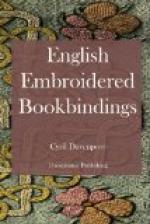The late Lady Charlotte Schreiber, who was a great collector of pieces of old embroidery, among a host of other curious things possessed the only perfect instance of work of this kind of the seventeenth century I have ever been fortunate enough to find. It was a very realistic caterpillar, closely and completely worked with very small pieces of peacocks’ feathers, sewn on with small stitches, quite confirming the opinion I had already formed as to the original filling in of the usual ‘bald’ spaces representing such objects.
Bible. London, 1619.
A copy of a Bible, printed in London in 1619, is bound in white satin, and measures 6 by 3-1/2 inches. On each side is an emblematic figure enclosed in an oval; the figures are different, but their surroundings are alike. On the upper side a lady holding a palm branch in her right hand is worked in shading-stitch. She is full length, and wears an orange skirt with purple robe over it confined by a blue belt, and over her shoulders a pink jacket—all these garments are outlined by a gold cord. Her fair hair is covered by an ornamental cap of red and gold, and her feet are bare.
The ground is worked with coloured silks and threads of fine wire closely twisted round with coloured silks, and the sky, painted in gradations of pink in water-colours, is worked sparsely with long stitches of blue silk.
[Illustration: 36—Bible. London, 1619.]
The lower side shows a female figure worked in a similar way; in this case she bears in her right hand some kind of wand or spray, which has nearly worn off, and in her left a bunch of corn or grapes, or something of that kind which has also badly worn away. If the first figure may be considered to represent Peace, this one may perhaps be Plenty. She wears a deep purplish skirt, with full over-garment and body of the same colour, with an under-jacket of white and gold. On her dark hair she has a blue flower with red leaves. Her feet are bare. The ground and sky are both worked in the same way as the other side. Both figures are enclosed in a flat oval border of gold thread, broad at the top and narrowing towards the foot. In the corners are symmetrical arabesques thickly worked in gold, and within the larger spaces in each corner-piece are the ‘remains’ of feathered caterpillars, now skeleton forms of threads only. The back of the book is particularly good, and most beautifully worked. It is divided into five panels, within each of which is a conventional flower, a cornflower alternating with a carnation, and the colours of all of these are marvellously fresh and effective. Among embroidered panelled backs it is probably the finest specimen existing.
[Illustration: 37—Emblemes Chrestiens. MS 1624.]
Emblemes Chrestiens, par Georgette de Montenay. MS. a Lislebourg. [Edinburgh] 1624.




